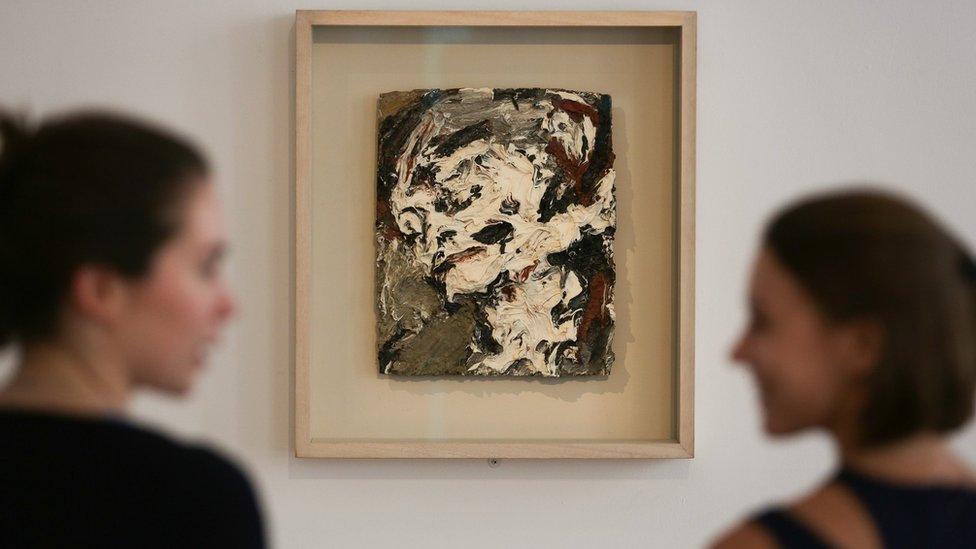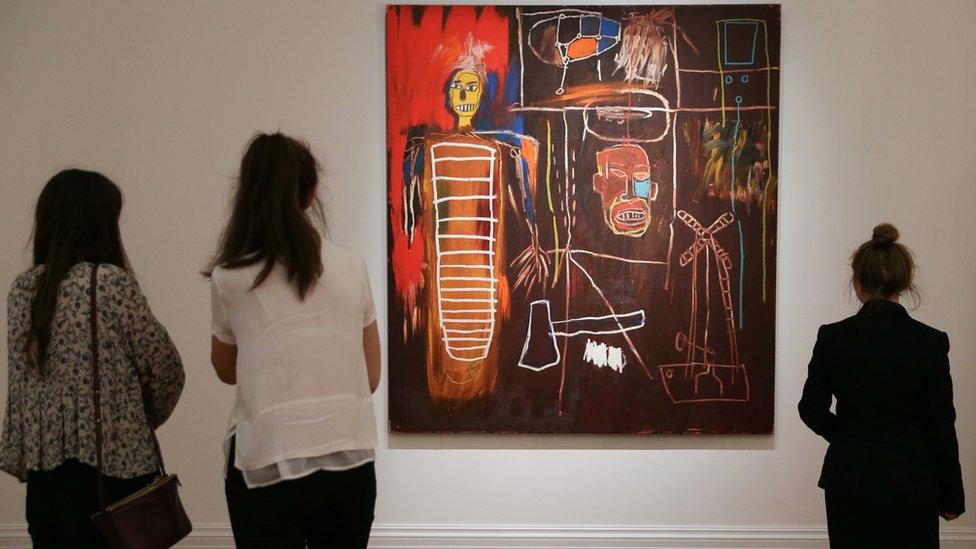What does David Bowie's art say about him?
- Published
David Bowie's art on show ahead of Sotheby's auction
First things first: The Sotheby's sale of David Bowie's art collection is only partial, in that it's not all there.
His family has kept a large chunk back - maybe around a third - including a Lynn Chadwick sculpture called Teddy Boy and Girl.
According to Kate Chertavian, his art buying advisor between 1992-2000, this is the artwork that precipitated an eight-year fine art spending spree by the late pop star, the results of which make up the bulk of what will go under the hammer next Thursday.
Nobody was very keen to talk about the art that's not in the sale, but I got the sense that the auction contained the pieces that either had less emotional resonance with his family, or were deemed to be the weaker works: what you might call the B-side of his art collection.
There are some decent pieces, though. Not least, William Scott's Girl Seated at a Table (1938).
If I had the £150,000-£250,000 the estimate requires (I don't, and it'll probably go for more anyway) I'd willingly stump up the money.
It's earlier - and I think better - than Scott's more abstract efforts, painted when the artist was channelling Cezanne, not Braque.

Head of Gerda Boehm by Frank Auerbach, with an estimated price of £300,000-£500,000
There are also two very nice, small Frank Auerbach sketches, a Kenneth Armitage bronze sculpture called Model for Diarchy (small version - 1959), and a Bernard Leach pot, all of which took my fancy.
Of course, art appreciation is a subjective activity, but there are some works in the pre-sale show, which is free to see by the way, that did absolutely nothing for me.
The two big paintings by Peter Howson left me cold, as did the group of large, colourful expressionistic pieces by John Bellany - although his Fishermen in the Snow (1965) was easier on the eye.
There are a couple of so-so Basquiat's, a decent Frank Auerbach oil and a reasonable Picabia - if that's your cup of tea (it's not mine). But by and large it is a collection of good but not great art.
An enigma
But that's not really the point, is it. The point is that David Bowie owned it. And he was special. A great artist in his own right who touched the lives of millions of people around the globe, but remained an enigma to most.
Which is why the 350 artworks and objects on show are so fascinating. What do they tell us about the collector?
Well, he was old school in his tastes in terms of materials. He liked paintings and sculptures.

Air Power by US artist Jean-Michel Basquiat, with an estimated price of £2.5m-£3.5m
There are no photographs, which is surprising considering it is a medium he clearly understood and used a lot in his own work.
Similarly, there are no video pieces, no performance art and - other than a couple of Duchamp bits - precious little from the conceptual canon.
His taste appears to have been fairly conservative but very specific. He liked British modernism.
He liked the art that came from the same place as him: mid-20th Century UK. It is art that you could argue shared his philosophy, a philosophy that went on to shape his aesthetic.
It is art that questioned, that was preoccupied with the surface, that had many sides; that never quite settled. Art that performed.
The collection strikes me as more about Bowie putting down roots rather than an exercise in creative experimentation: it was for contemplation and ballast, not rock 'n' roll.
- Published1 November 2016

- Published14 July 2016

- Published14 July 2016

- Published14 July 2016

- Published26 June 2013
